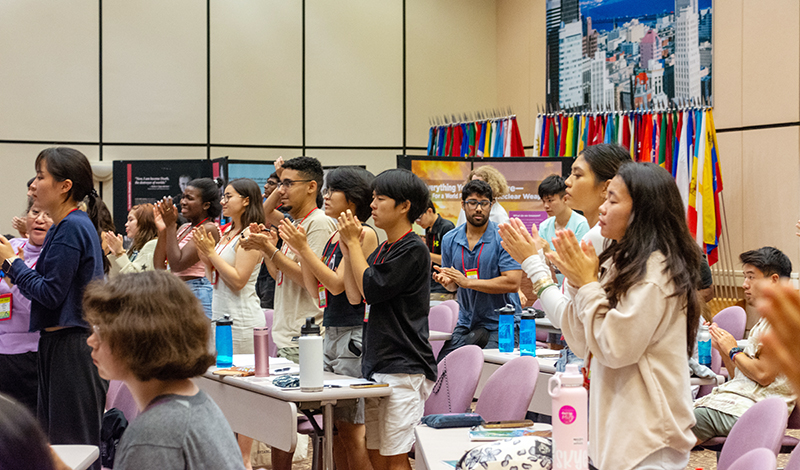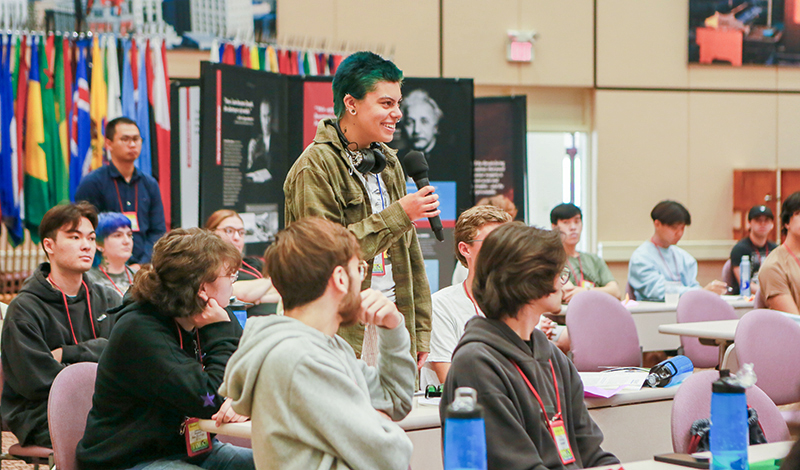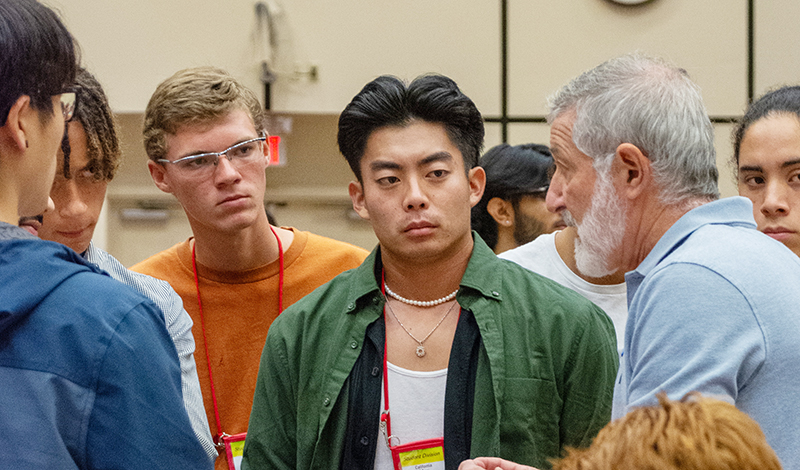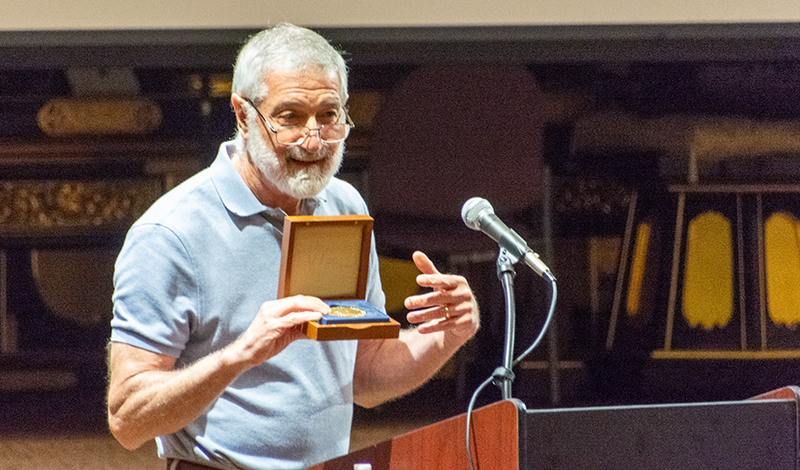Dr. Ira Helfand is a member of the International Steering Group of the International Campaign to Abolish Nuclear Weapons (ICAN) and is a co-founder and past president of Physicians for Social Responsibility, the U.S. affiliate of the International Physicians for the Prevention of Nuclear War. Dr. Helfand traveled in late July to the SGI-USA Florida Nature and Culture Center in Weston, Florida, to give a lecture on nuclear abolition at the SGI-USA Student Division Conference. Below is a sampling of Dr. Helfand’s responses to questions from student division members. The text has been condensed for brevity and clarity.
Q: My grandfather was Jewish and lived in Czechoslovakia during World War II. After Hitler took over [Nazi Germany occupied the country from 1938–45], his family members were all sent to concentration camps. My grandpa escaped and spread his message about love and peace around the world. One thing I’ve always struggled with is that, if one country gives up its weapons before others, that makes them vulnerable to attack. I wonder what advice you have for people who think that way, and how to deal with that?
Dr. Ira Helfand: That is a question that is at the heart of most of the resistance today of abolishing nuclear weapons. It is very important.
I do not personally advocate unilateral disarmament by the United States, because, well, three things. One: It wouldn’t get rid of the problem if the other countries still had the weapons. Two: It might make things even more unstable. And three: It’s just a political nonstarter. You can’t get anyone to advocate in the government for unilateral disarmament.
[The U.S.-based coalition] Back from the Brink[1] does not explicitly call on the United States to sign the Treaty on the Prohibition of Nuclear Weapons[2] right now, which would require them to disarm unilaterally. What it does call on the United States to do is to exercise leadership—to bring together all of the countries that do have nuclear weapons and try to get them to negotiate a verifiable, enforceable, time-bound agreement by which they would get rid of their nuclear arsenals simultaneously and get to universal disarmament. And I think that it’s the position we should advocate for.
What we need to do is to get [nuclear-weapon states] to understand that, No. 1,
they can absolutely never use the weapons; it would be suicidal to do so. No. 2, that continuing to possess these weapons just creates a totally unacceptable risk. As a national security question, not just as a moral question, it is imperative that the United States and each of the other nuclear-weapon states seek the elimination of these weapons worldwide. Because if they aren’t eliminated, they are going to get used at some point. And that is going to be the ultimate disaster for all of us.
So, I think that this is the key part of the answer: We advocate for universal, not unilateral, disarmament.

Q: How do you think we go about creating a world that is based on community rather than individuality?
Dr. Helfand: I do think that this effort to get rid of nuclear weapons does have some significant potential in that regard. Part of what we’re saying is that [we should rid the world of nuclear weapons] not just because it is the right thing to do but because it’s what we have to do. We have to behave differently. In a world where the climate crisis threatens human survival, nuclear war threatens human survival, and perhaps the next pandemic—and there will be another one—threatens human survival, it is imperative the countries cooperate rather than compete.
I think, of all of these problems, getting rid of nuclear weapons—as big a deal as it is—is the easiest to solve. Getting rid of the climate crisis requires us to change the way a billion people live, to totally redesign the global economy. Getting rid of nuclear weapons just requires us dismantling 13,000 [weapons], which would take us about five years. It’s an easy problem, once we make the decision to do it.
The process of creating that decision, though, would create an entirely new dynamic among the countries of the world, especially the great powers.
It could be a a model—that cooperative community model—for them to adopt going forward. And the same kind of activity to bring about nuclear abolition could also serve to build community at a more local level.
We can actually model Back from the Brink. Our tagline is Back from the Brink: Bringing Communities Together to Prevent Nuclear War. We welcome individuals to participate, but what we are really trying to get are organizations, communities, to be the building blocks for our coalition, to urge people to try to figure out what networks, what communities, they belong to—faith communities, civic groups, professional associations and so on—that they can reach out to in order to amplify their voice and get that whole community of people to speak to the need of getting rid of nuclear weapons.
So perhaps through necessity, this issue will help us build a more community-based society.


Q: I am a fourth-year medical student. As I’ve gone through my schooling, I’ve learned to choose not to go down paths that I feel like will lead to a dead end. And whenever I think about the abolition of nuclear weapons, it’s getting difficult for me to not see it as a dead end. It requires cooperation from all ends. That [requirement], I feel, does lead us to a dead end. The alternative is just sitting and doing nothing. But I don’t think I’m willing to accept that either. How can I contribute despite these misgivings?
Dr. Helfand: I think, when faced with difficult tasks, we do tend to assume prematurely that you can’t succeed and that there’s a dead end there. And sometimes, I think we also use the perception that there is a dead end as an excuse to not do anything. That’s another part of the equation.
If we don’t get rid of these weapons, I think it’s not a high probability, it’s a certainty, that they are going to be used, and all these terrible things I talked about are going to happen. So, if we accept that it’s a dead end, [that eventuality is] what we’re accepting.
And so, we have to make the assumption that, even though it may look like a dead end, maybe there’s some way out of this; and we should assume that it’s at least possible to find a solution.
We see this all the time in action movies. The hero or the heroine is faced with certain death, but they don’t give up. And sure enough, they figure out some way out of it. We have to hope that that’s what’s going to happen.
We can take some inspiration from what happened in the 1980s. I mean, we were headed to nuclear war. In the summer of ’83, we came within minutes—twice. And, at that time, the arsenals were even bigger. We would not be here today if either of those wars had taken place.[3]
We are the heroes and heroines trapped in this life-threatening situation; we have got to get out of this place. When we approach it like that, it makes sense to try—and to try with some hope, because we have been successful in the past.
I’m optimistic. I talk about this all the time; I kind of live with it. And I believe that we are able to solve this problem. As someone going into the medical profession, you’re going to have patients who are really ill who you won’t give up on. Think of the world as your patient. You can’t give up on it.
August 18, 2023, World Tribune, pp. 8–9
References
- Back from the Brink is a U.S.-based grassroots coalition of individuals, organizations and elected officials, including the SGI-USA, working together toward a world free of nuclear weapons. ↩︎
-
The Treaty on the Prohibition of Nuclear Weapons (TPNW) is the first legally binding international agreement to comprehensively prohibit nuclear weapons with total elimination as the ultimate goal. The treaty was adopted on
July 7, 2017, and entered into force on Jan. 22, 2021. For those nations that are party to it, the treaty prohibits the development, testing, production, stockpiling, stationing, transfer, use and threat of use of nuclear weapons, as well as assistance and encouragement to the prohibited activities. For nuclear armed states joining the treaty, it provides for a time-bound framework for negotiations leading to the verified and irreversible elimination of its nuclear weapons program. ↩︎ - In September 1983, during the Cold War, the Soviet nuclear early warning system inaccurately reported the launch of intercontinental ballistic missiles from the United States. A Soviet Air Defence Forces engineer waited for corroborating evidence rather than immediately relaying the warning up the chain of command. This decision prevented a retaliatory nuclear strike against the United States and its NATO allies, which would likely have resulted in a full-scale nuclear war. It was later determined that the system had malfunctioned. ↩︎
You are reading {{ meterCount }} of {{ meterMax }} free premium articles

